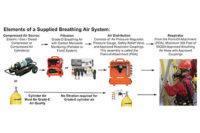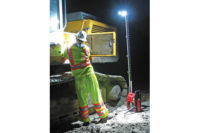The buyer bears responsibility
Federal OSHA has no requirements for manufacturers and distributors to sell products tested and certified for use in the United States. OSHA requires the company or person purchasing the electrical fan or blower to ensure that the product is “acceptable” to U.S. OSHA. More than 25 years ago, OSHA started the Nationally Recognized Testing Laboratory (NRTL) to use nationally recognized electrical standards for testing portable fans and blowers. NRTL has a list of approved companies and organizations that meet OSHA’s requirements to certify products and to use their logo on the product to signify the product has passed U.S. (or Canadian) electrical standards. Here are only a couple NRTL-approved organizations — Intertek and Canadian Standards Association:
Review the label
If the product has an NRTL logo, the 4 o’clock position will designate the product has been certified for sale in the U.S.; the 8 o’clock position will designate the product has been tested under Canadian electrical standards and approved for sale in Canada. Both countries have different electrical standards, and the NRTL logo could have only a “C” approval for Canada and only one “US” approval for sale in the U.S.
One of the most important steps for the purchaser of electrical equipment is to review the label on the equipment. The NRTL must label what environment the fan or blower has been tested and where to use this equipment. In the case of the town that purchased the standard blower, they should have reviewed the blower’s label and seen that it would not be approved for a hazardous location. Selecting an explosion-proof certified blower or fan, the label would tell the user that the device has been certified by the NRTL for use in the hazardous location designation and in what electrical Class and Group this equipment has been certified for use. Many manufacturers supply electrical equipment that may have an explosion-proof motor, however, the fan unit has not been certified explosion-proof by an NRTL.
The OSHA-approved NRTL logo for U.S. and Canada is not approved for explosion-proof fans and blowers sold in Europe (EU).The EU has a certification agency called ATEX (not part of the NRTL) for testing and certifying electrical equipment used in hazard locations. The ATEX signifies with the logo at left that the fan or blower has passed ATEX certification for sale in Europe. However, the ATEX electrical certification logo is not approved by U.S. and Canadian electrical standards. The approved NRTL logo must be affixed to the fan or blower for sale in the U.S. or Canada.
Worth the investment
The cost of $3,000 to $5,000 to have a piece of electrical equipment tested and certified by an NRTL is expensive; however, the cost of a product liability lawsuit can exceed $1,000,000 easily. A manufacturer should have its products electrically certified by an OSHA-approved NRTL; it is a way of business life, but no federal laws require that the manufacturer or distributor must comply. OSHA laws for certified electrical equipment — fans and blowers included — apply only to the end-user customer. The company or person who purchases the product and places it into service must ensure that the product is “acceptable” to OSHA, and it must be certified by an NRTL.
You can buy a safe fan or blower for use in confined spaces if you read the manufacturer’s label. Always check the NRTL-approved label and decide whether the device can be used in your work location in the U.S., Canada or both.




